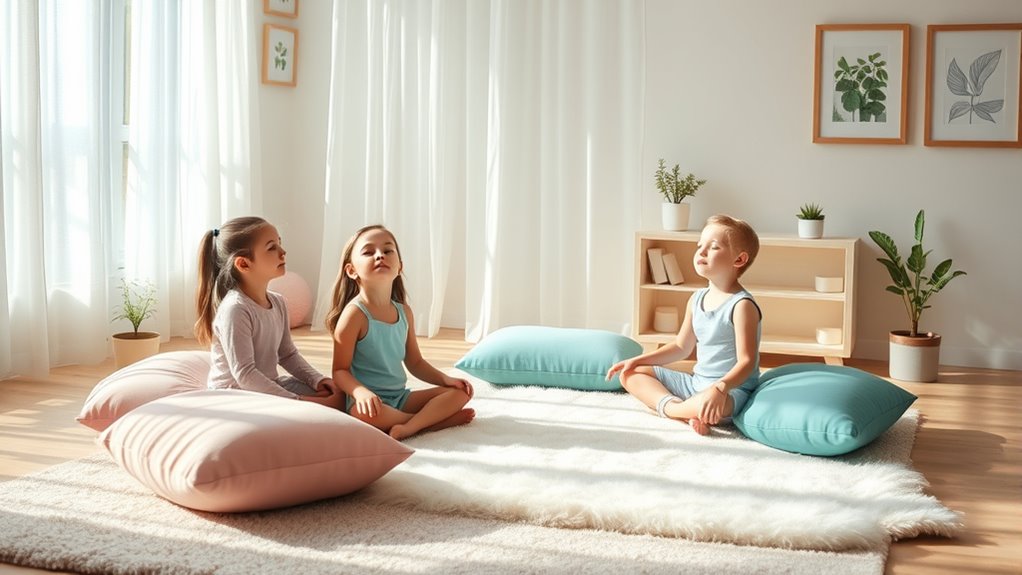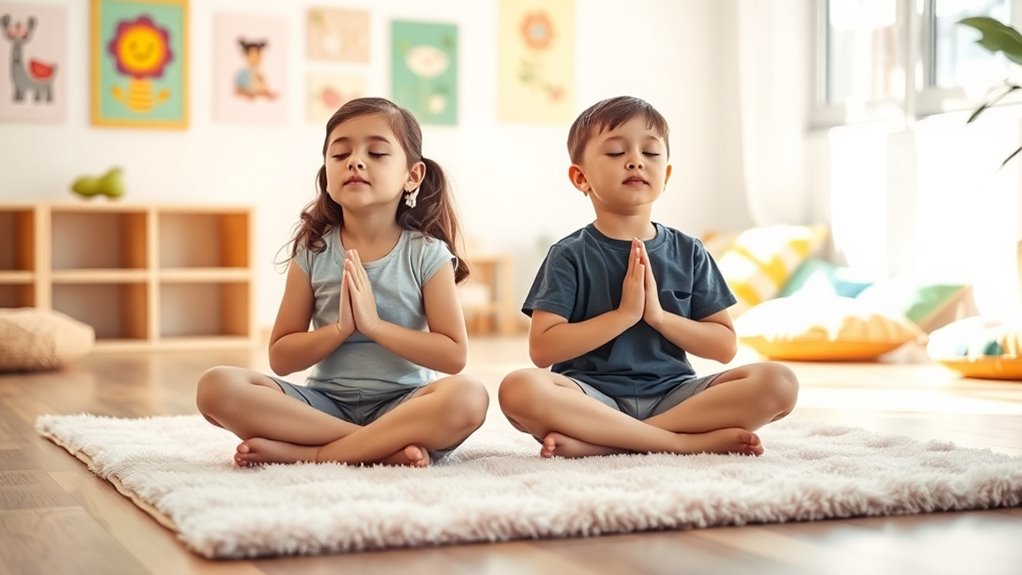To help your child cultivate calm early, introduce simple meditation practices like deep breathing and mindfulness exercises. Encourage them to focus on their breath or notice sensations around them to build awareness and emotional resilience. Making these techniques a daily habit can improve their focus, reduce anxiety, and promote a sense of calm. Keep exploring different tools and techniques, as there are many effective ways to foster lasting emotional wellness in children.
Key Takeaways
- Introducing short, guided meditation sessions helps children develop calmness and emotional resilience early.
- Breathing exercises teach children to manage anxiety and stay centered throughout their day.
- Mindfulness practices encourage present-moment awareness, reducing worries and promoting emotional regulation.
- Establishing consistent routines with meditation fosters long-term emotional well-being and focus.
- Visualization techniques and grounding exercises enhance relaxation and help children navigate daily challenges.

Have you ever wondered how meditation can benefit children? It’s a powerful tool that helps them develop emotional resilience, focus, and a sense of calm amidst daily challenges. One of the simplest and most effective ways to introduce meditation is through breathing exercises. These exercises teach children to pay attention to their breath—deep inhales and slow exhales—that can quickly shift their mood and reduce anxiety. When you guide a child through breathing exercises, you’re helping them build awareness of their body and mind, fostering a sense of control over their emotions. For example, encouraging them to take a deep breath in for a count of three, hold it for a count of two, then exhale slowly for four counts creates a calming rhythm. Repeating this a few times can help a child feel more centered, especially during stressful moments like before a test or after a disagreement.
Incorporating mindfulness practices into daily routines makes meditation accessible and relatable for children. These practices involve paying close attention to the present moment without judgment. You might ask a child to notice the sensations of their feet on the ground or the sounds around them during a walk. When children focus on their immediate experience, they learn to detach from worries about the past or future, which often cause distress. Mindfulness exercises can be as simple as asking them to listen carefully to the hum of a refrigerator or to observe the colors and textures of their surroundings. Over time, these practices help children develop a habit of grounding themselves when they feel overwhelmed or distracted. Research shows that meditation techniques tailored for kids can improve their emotional regulation and reduce anxiety.
You don’t need fancy equipment or lengthy sessions to make meditation effective for children. Starting with just a few minutes a day, focusing on breathing exercises or mindfulness practices, creates a foundation for emotional regulation. As they become more comfortable, you can introduce guided meditations or visualization techniques that encourage imagination and relaxation. The key is consistency—making meditation a regular part of their routine helps children internalize these skills, which can serve them well throughout their life. By teaching kids how to pause, breathe, and observe their thoughts, you’re empowering them to navigate their emotions more effectively, fostering resilience and a sense of calm that lasts well beyond childhood.
Frequently Asked Questions
What Age Is Best to Start Teaching Meditation to Children?
You can start teaching meditation to children as early as age three, considering their age considerations and developmental readiness. Early intervention helps children develop emotional regulation and focus skills, making it beneficial even for preschoolers. Keep sessions short and engaging, using simple techniques suited for their age. By introducing meditation early, you foster lifelong calmness and resilience, setting a solid foundation for their mental well-being as they grow.
How Can Parents Encourage Consistent Meditation Practice at Home?
Did you know that children who meditate regularly show a 25% reduction in stress? You can encourage consistent practice at home by actively involving yourself—join your child in meditation sessions and make it fun. Creating routines helps, so set a specific time each day. Parental involvement is key; your support and enthusiasm make meditation a natural, enjoyable habit for your child.
Are There Any Risks or Downsides to Meditating for Young Children?
You should be aware that potential drawbacks of meditation for young children include developmental concerns if sessions are too long or intense, potentially causing frustration or distraction. Some children might find it hard to focus or become overwhelmed, so it’s essential to keep practice age-appropriate and gentle. Always watch for signs of discomfort or resistance, and adapt your approach to guarantee meditation remains a positive, calming experience.
What Are Some Simple Meditation Techniques Suitable for Preschoolers?
Did you know that 75% of preschoolers experience frequent stress? You can introduce simple meditation techniques like breathing exercises, where your child takes slow, deep breaths to settle down. Guided imagery is also effective—encourage them to imagine their favorite peaceful place. Keep sessions short, fun, and consistent, helping your little one develop calmness and focus early on.
How Does Meditation Impact Children’s Emotional Development Long-Term?
You’ll find that meditation helps children build emotional resilience and improve stress management over time. As they learn to focus and regulate their emotions, they become better equipped to handle challenges calmly and confidently. This practice fosters self-awareness and patience, which supports healthy emotional development long-term. By cultivating these skills early, you set your child up for better emotional well-being and stronger coping mechanisms throughout their life.
Conclusion
By introducing meditation early, you help children find calm in chaos, focus amidst distractions, and build resilience against stress. You teach them to breathe deeply, to pause intentionally, and to stay present fully. With each practice, they grow calmer, more centered, and more confident. As they cultivate mindfulness, they learn to navigate life’s challenges with clarity, patience, and grace. In guiding their minds, you help shape their future—calm, resilient, and mindful.








